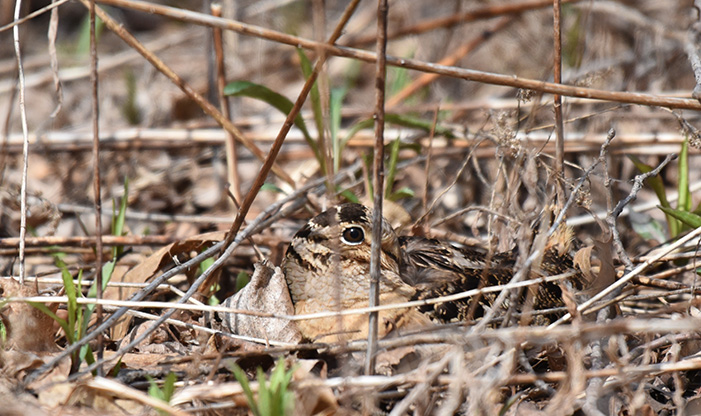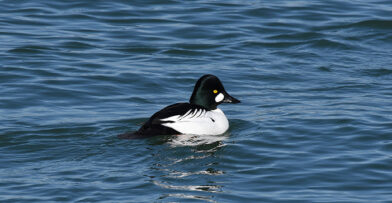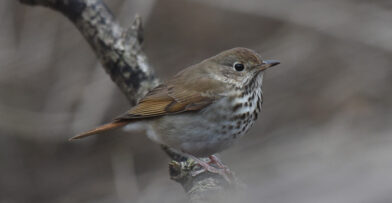Our Bird Profile series highlights a species that is migrating through, breeding, or is a year-round resident of Wisconsin that can be found at Schlitz Audubon or in your backyard.
Name
American Woodcock, Scolopax minor
Basic Description & Appearance
The American Woodcock is a plump, compact shorebird, also referred to as timberdoodle and night partridge, among other folk names. Males measure 10-12 inches and weigh 5-8 ounces, with females being significantly larger. The nape of their head is black, with 3-4 rufous crossbars, and large, dark eyes set high on their head, giving them a 360-degree horizontal field of view. Their chest and sides are yellowish white to tan, with mottled brown, gray, and black plumage and a large, 2.5-3-inch flexible bill.
Vocalization & Displays
This bird species is hard to find due to its camouflage-like feathers but takes the spotlight at dawn and dusk during spring courtship displays, beginning around March in the northern range of their territory and as early as December in their southern range. Males start their display on the ground, trying to impress any females present with their peent call, then flying upward and descending in a zig-zag pattern while making loud, chirping sounds. Back on the ground, the male continues its peent call, sometimes displaying this sky dance well into the evening.
Habitat & Nesting
The American Woodcock breeds in the northeastern US and southeastern Canada, with year-round and overwintering territories spread in the southeastern US into Texas and Florida. While they are classified as shorebirds, they have adapted to forest habitats, preferring young deciduous forests, abandoned farmland, forest openings, and shrubby fields. These areas provide leaf litter for camouflage, rich soil where they probe for invertebrates, and the open spaces necessary for their courtship displays.
Males will breed with multiple females within their territory and take no part in caring for their young. Females of this species make their nests on the ground, creating a depression in the leaf litter. They lay 1-5 eggs per brood. The chicks are precocious and leave the nest with their siblings within a few hours after hatching, when they are dry. Within 3-4 days, the young start to look for food, though they rely on the parent bird for food for about a week. They become fully independent from their siblings within a month.
Diet & Foraging
The rich soil in their preferred habitat is best for a diet consisting predominantly of earthworms. They also eat other invertebrates, including millipedes, spiders, and beetles, and occasionally some plant material, including sedges, pigweed, and members of the rose family.
The American Woodcock performs a waddling walk while foraging, bouncing up and down to create vibrations, causing the earthworms to make more sounds and become audible to the bird.
When & Where to Find at Schlitz Audubon
This species is found in our forest habitats near wetlands, mostly in March and April, sometimes seen during their sky dance displays, but is more difficult to see when in their ground habitat. The American Woodcock is a species of least concern, but their population has declined since 1966, mostly due to habitat loss.
Other Fun Facts
- The bill of the American Woodcock is long and flexible at the tip, making it the perfect tool for foraging earthworms.
- When this bird species performs its sky dance, it ascends as high as 300 feet before it zig-zags downward.


